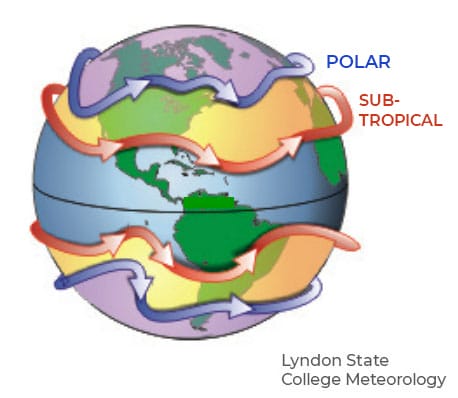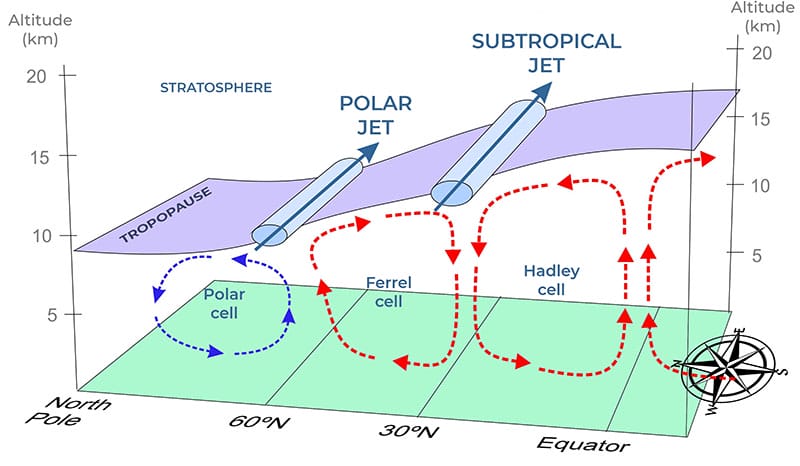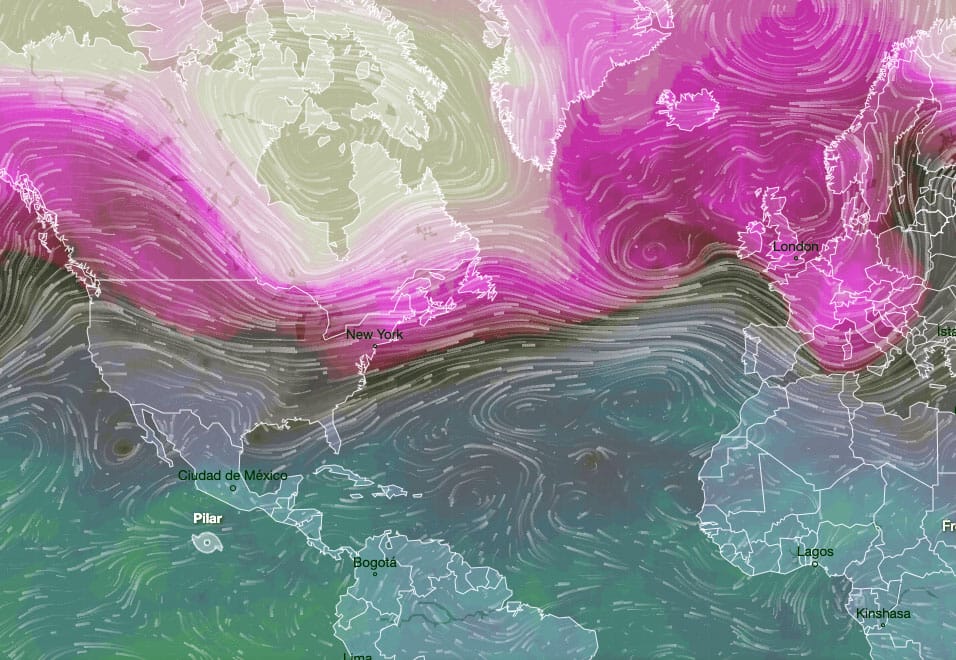You rarely hear about them, but jet streams are an atmospheric phenomenon that significantly affects aspects as important as the climate or, within the aeronautical field, the duration and stability of certain flights and even the economy of some airline companies.
These are gigantic flows of air that circulate at high speeds in our atmosphere. In general, when someone mentions “the jet stream”, they usually refer to two in particular: the polar front or the subtropical front, two important phenomena that are an essential part of weather patterns around the world.
Huge flows of air that move through the atmosphere at high speed and significantly affect the climate and, specifically, air navigation.
According to the World Meteorological Organization, a jet stream is “a strong, narrow stream of air concentrated along a nearly horizontal axis in the upper troposphere or stratosphere, characterized by strong vertical and horizontal wind shear. It normally runs for several thousand kilometers, in a strip several hundred kilometers wide and several kilometers thick”. Actually, it is not a phenomenon that occurs only on Earth but has been detected in the atmosphere of other planets in our Solar System.
There are various jet streams in our atmosphere that are found around the tropopause, the transition zone between the troposphere and the stratosphere. The tropopause is located at a variable altitude ranging from 9,000 meters at the poles to 17,000 meters at the Earth’s equator, being a very relevant area in air navigation as it is the main setting for commercial flights in their cruise phase. In the troposphere, the surrounding temperature decreases with altitude until reaches values around -60ºC, while from the tropopause, as we rise in the stratosphere, the temperature increases until it reaches around 0ºC.
 Regardless of the Earth’s hemisphere in which we might find ourselves in, winds in jet streams travel from west to east, with speeds ranging between 125 and 225 kilometers per hour, although they can exceed 400 kilometers per hour. Their shape is highly variable, although long meandering flows that constantly evolve and occasionally move to higher or lower altitudes prevail. They branch and join again, creating eddies and modifying their flow, depending on various factors. They are mainly caused by a combination of the effects of the planet’s rotation on its axis and atmospheric heating due to solar radiation.
Regardless of the Earth’s hemisphere in which we might find ourselves in, winds in jet streams travel from west to east, with speeds ranging between 125 and 225 kilometers per hour, although they can exceed 400 kilometers per hour. Their shape is highly variable, although long meandering flows that constantly evolve and occasionally move to higher or lower altitudes prevail. They branch and join again, creating eddies and modifying their flow, depending on various factors. They are mainly caused by a combination of the effects of the planet’s rotation on its axis and atmospheric heating due to solar radiation.
A polar jet stream and a subtropical one exist in both the north and south terrestrial hemispheres. In the northern hemisphere the polar current travels over the middle and high latitudes, around 60º (over Asia, Europe and North America, as well as the Pacific and North Atlantic). In the southern hemisphere, however, the polar current is limited almost all its way to the Antarctic continent. During the winter, jet streams tend to follow the elevation of the sun and move towards the equator, while in spring they return toward the poles. They are located at an altitude ranging between 8 and 12 kilometers above sea level.
Subtropical jet streams, in turn, evolve in the middle latitudes (about 30º) of both hemispheres and at a higher altitude, between 10 and 16 kilometers, being weaker than the polar ones.
As jet streams evolve vertically or separate to join at another point, they move immense masses of air, creating changes in global weather patterns.
In the field of air navigation, these phenomena are essential to understand the turbulence that affects flights or the fact that the flight time for the same journey can be much shorter or longer depending on whether we fly east or westward.
 The cruising altitude of commercial flights is usually around the tropopause, right where ´jet streams circulate. They do this to take advantage of the low density of air, which allows them to reach higher speeds while lower fuel consumption. Furthermore, at that altitude you will not encounter intense weather phenomena or birds that could affect flight.
The cruising altitude of commercial flights is usually around the tropopause, right where ´jet streams circulate. They do this to take advantage of the low density of air, which allows them to reach higher speeds while lower fuel consumption. Furthermore, at that altitude you will not encounter intense weather phenomena or birds that could affect flight.
When airline pilots plan a flight, one of the elements they usually take into account is the location of the jet streams and their intensity along their planned route. For a flight running in the same direction as a jet stream, joining that mass of moving air can represent an additional “push” that will significantly reduce the time to complete the journey while reducing fuel consumption. Conversely, encountering strong headwinds would have the opposite effect, which is why they try to avoid them by modifying the route to follow.
A very clear example of this phenomenon can be observed in flights between the United States or Canada and Europe crossing the Atlantic Ocean. Under conventional circumstances, a flight between New York and London should take about 6 hours and 15 minutes. Recently, a Norwegian plane made the shortest subsonic journey between both cities with a time of 5 hours and 13 minutes thanks to tailwinds of up to 300 km/h, which propelled the aircraft to a maximum speed of 1,249 km/h . Shortly after, a British Airways Boeing 747 shattered that record by making the same journey in 4 hours and 56 minutes, at a speed of 1287 km/h and, along with it, a Virgin Airbus A350 did the same, taking only one minute more. In these two cases, the record was caused by Superstorm Ciara (2020), whose origin was in the polar jet stream.
In general, using these currents to cross the Atlantic saves time between 30 and 45 minutes on average for airlines, which translates into a very significant reduction in fuel consumption which, in turn, means a reduction in the emission of greenhouse gases. If, on the other hand, the flights are in the opposite direction, the consequences would be the opposite.
Although there are many parameters to consider and, therefore, defining a specific figure can lead to confusion, it is likely that the approximate and indicative overall reduction in flight times thanks to jet streams will generate savings of more than 55,000 tons of aviation fuel per year, which means approximately the emission of 175,000 tons of CO2 less per year.
Another aspect in which jet streams play a role is the turbulence that we usually experience during flight. These types of currents are the ones that are usually at the origin of the so-called “clear air turbulence”, which are invisible, unpredictable and more common during the first hours of the day, which give rise to minor shaking of the plane. You can find more detailed information about turbulence in this post.

There are various theories and studies addressing the way in which global warming is affecting jet streams, in such a way that they can predict to a certain extent what the variation in climate patterns will be or how they will affect air navigation in the future. Nevertheless, it can be said that the main conclusion is that, there are no clear conclusions.
Trustworthy and reliable groups of experts conclude that global warming is gradually pushing the jet streams poleward, confirming that the northern jet stream has moved northward at an average rate of 2.01 kilometers per year between 1979 and 2001, with a very similar trend in the southern hemisphere’s jet stream. They have also raised the possibility that the jet stream is also gradually weakening. However, other scientific studies have shown that between 2002 and 2020 the North Atlantic jet stream had strengthened without any obvious latitudinal shift.
A 2021 study conducted at the University of Arizona using ice cores from Greenland was able to reconstruct jet stream patterns over the past 1,250 years, revealing that all recently observed changes remain within the range of natural variability.
Undoubtedly, jet streams are (and will continue to be) an essential part of some aspects of our lives, especially our interaction with the atmosphere, although the vast majority of the population still does not really know of their existence.
Lastly, it is worth mentioning that the name “jet stream” was coined by the German meteorologist Heinrich Seilkopf who, in 1939, described the phenomenon as “Strahlstrom”. It was not until the end of the world war however that its nature began to be delved into, constituting a fundamental milestone to understand, from that moment until today, the functioning of the Earth’s atmospheric circulation.



